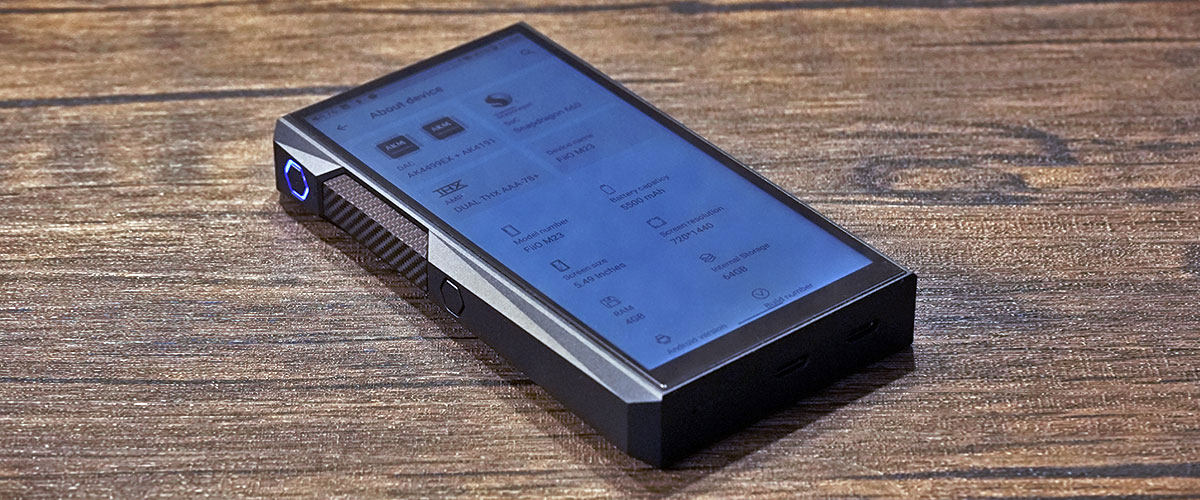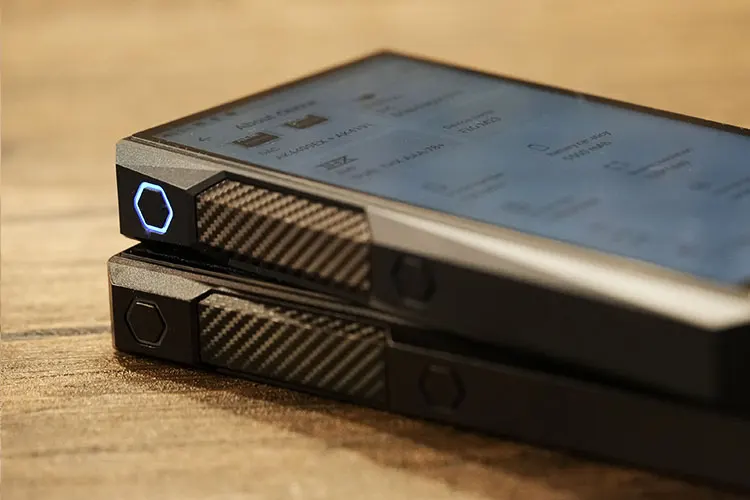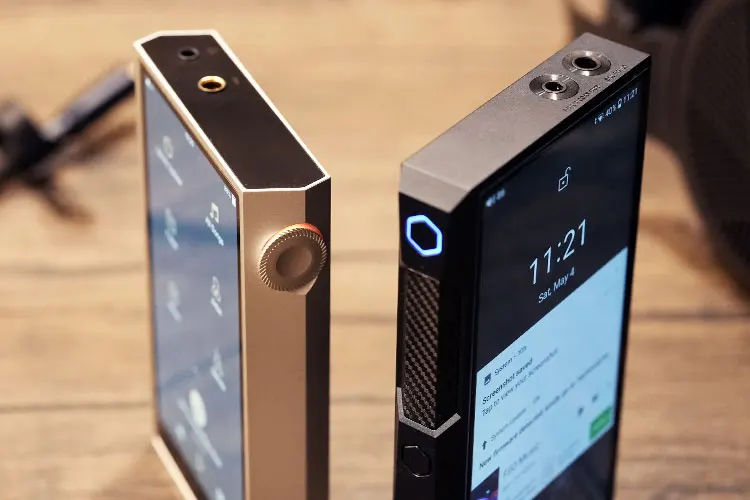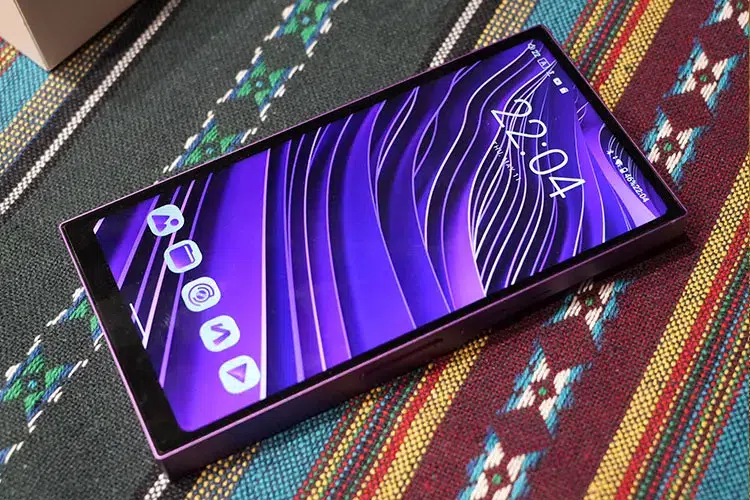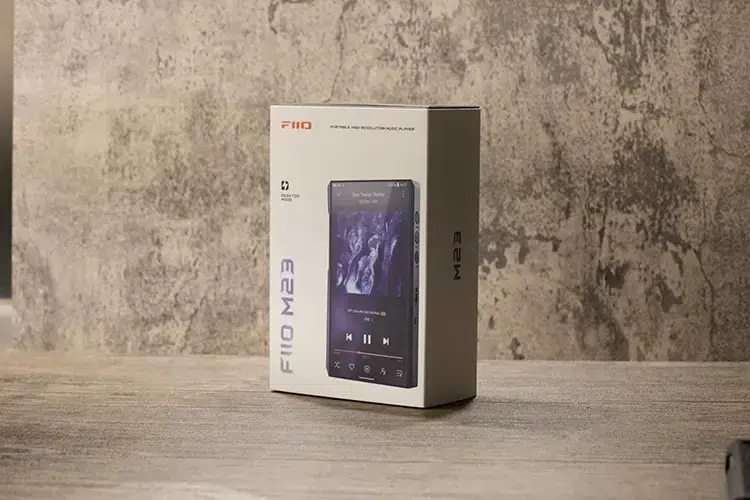Select Comparisons
FiiO M11 Plus ESS
Offered at the same price many areas are being upgraded on the M23 when compared to the M11 Plus ESS from the previous generation.
Technical
First of all, the M23 steps up to the flagship AKM AK4499EX + AK4191EQ for decoding compared to M11 Plus ESS’s dual ES9068AS.
The M23 also has an upgrade in amplification to THX AAA-78+*2 which nearly doubles its balanced output level and 2.5x the power for SE output. This is now more user-friendly for SE 3.5m users who complain about a lack of power.
Technically the M23 is also more proficient with <0.00046% THD+N performance @32Ω load tested at High gain mode, compared to <0.00085% on the M11 Plus ESS.
The voltage swing is also increased by 60% up to 23.5Vp-p, which makes it much more capable of handling higher-impedance headphones such as the ZMF Headphones Atrium Closed.
Design
A similar design language is applied to the M23, but it has a cooler Matte Navy-Blue paint job that looks even more appealing than the standard black color.
The two devices may look quite similar but the M23 has included some new features that are more practical for everyday use. These include dual USB charging slots with faster charging speeds supported.
Another key difference is the output jack placement on the top side and the card slot moved to the bottom panel. I find this a good move and the decoration rings around the output jacks make the M23 look classier.
Aside from the aesthetics, the battery is 500mAh less on the M23, and its playback time is reduced from M11 Plus ESS’s 14-hour lifespan to 10.5 hours. This is reasonable as the output power is higher.
Performance
The new hardware upgrades undoubtedly give the M23 some advantages in technicalities.
You can hear better detail retrieval, grander staging, better control, and balance in tone when put on higher loads especially when turning to the Desktop Mode or the Hifi boost mode. Distortion control, as well as the openness of treble on the M23, is also audibly better.
The tuning differences are quite distinguishable as the M11 Plus ESS sounds more colored and a better fit for streaming content and pop, with a more forward vocal sound.
The M23 sounds smoother, but at the same time retains more nuanced detail, making it more genre-flexible.
When fast powerful bass is played the M23 can recover faster and gives a stronger sense of precision, and even at higher volume, it holds together a firmer image.
This is more apparent when you pair the M23 with headphones that require a stronger current to drive. The Desktop Mode gives the M23 quite a bit more advantage in sounding more dynamic and airier.
Shanling M5 Ultra
Technical
The Shanling M5 Ultra is based on Shanling’s own MTouch 4.0 system and uses the same AK4191 and AK4499EX combo, with the Ingenic X2000 controller that has been seen on multiple Shanling devices.
The output power for the M5 Ultra goes as high as 1100mW@32ohm for balanced output and 315mW@32ohm for SE output, which suggests that its balanced output is around 10% higher than the M23 on paper.
On balanced output, the THD+N performance is 0.0007% on the M5 Ultra and 124dB for the S/N ratio, and FiiO M23 achieves <0.00038% and >125dB which is superior on paper.
As the M23 runs on an open Android platform supporting different apps, it is more flexible for streaming and other system features such as applying different filters and PEQ.
The M5 Ultra runs a much more lightweight OS and has Tidal in-built, but the usage of other streaming apps may be more limited.
Design
The Shanling M5 Ultra has a 4.7” 720p screen quite a bit shorter than the one on the M23. The volume control for the M5 Ultra is on the right side while M23 puts the volume slider on the left side.
The layout and ease of control are slightly better on the FiiO M23 as the M5 Ultra is thicker and has thinner, rectangular buttons, however, it is easier to wake the screen up with the M5 Ultra’s bigger on/off button which is at the same time the volume control.
Since the M23 has two USB-C ports you can charge it while outputting USB audio signal to other devices which is handier.
Both designs look fancy in their own way and both manufacturers have put in great effort in making the newer generation players more appealing and artistic, which adds to the overall experience.
Performance
While both M23 and Shanling M5 Ultra use the AK4191 + AK4499EX for decoding, their tuning is quite differentiated but there is one point in common, both devices sound quite smooth in the midrange but vary in intensity.
Their forte is different, and I find the M5 Ultra is a stronger match for sensitive IEMs, sounding more delicate in vocal reproduction. While the M23 is more optimized for instruments and works well with different genres.
The M5 Ultra is tuned to be more vibrant and lusher in the mids, with a richer and warmer tone that fits expressive Pop music, Dance, and EDM. The sub-bass is tuned more prominent with more authority for male vocalists.
In contrast, the M23 is smoother, and slightly softer in its attack, sounding more relaxing without compromising textures and speed. This allows it to work nicely with Classical music and instrumentals, or for vocalists with cleaner voices.
The streamlined architecture seems to help the M5 Ultra to outline the midrange with stronger transients and together with its fuller bass response, the vocal range sounds well separated and lush.
Running on AC power with the Desktop Mode does give M23 some edges on powering demanding headphones. It allows the treble to sound more articulate and brings up more micro-detail on the two ends of the spectrum, whereas the M5 Ultra feels less extended.
HiBy R6 Pro II
Technical
The R6 Pro II comes with Android 12 and uses the Snapdragon 665 SoC. It also features a Class A/AB switch for the amping circuitry.
Soon, the FiiO M23 will also receive an Android 12 firmware upgrade. Therefore, you can expect the UI experience to be quite similar, complemented by the two brands’ customization and DSP features.
The R6 Pro II features dual AK4499EX which supports up to DSD1024 native and PCM32Bit/1536kHz decoding.
The power output on the R6 Pro II is roughly 1/3 of the M23, measuring 125mW max for SE output and 383mW max with 32Ω loads on BAL output.
HiBy explained that it is optimized for sensitive IEMs, and clearly, it is well differentiated from the M23 which has a much stronger focus on power.
Design
The two devices weigh very similar in practice and the R6 Pro II features a 5.9-inch IPS screen with a 1080*2160 resolution that is higher than the 720*1440 resolution on the M23.
Despite this, if you are just using music apps then you may not notice much difference but when viewing videos the R6 Pro II does feel slightly sharper than the M23.
For the layout, the R6 Pro II places all outputs at the bottom and has separated jacks for PO and LO for both SE and balanced connections, while the M23 puts everything on top this time.
I would say physical control options are better on the M23 as it has a hold button, and the slider is also friendlier than the thin volume bar on the R6 Pro II.
Flipping to the back I really like how the R6 Pro II fuses different elements on the back panel and shapes the housing differently with curves.
The M23 also uses a mesmerizing, reflective material at the back and I am sure no matter which of the two devices you own you would struggle to not use the leather/jelly cases.
Performance
When testing with relatively sensitive IEMs like HiBy’s flagship Zeta IEM, the R6 Pro II excels in capturing bass transients, defining, and showcasing the finesse of vocals, and offering better dynamics and separation.
It exhibits a stronger sense of layering, texture, and liveliness in the bass. However, it may not be as elaborate or impact the sub-bass as solidly as the M23, which also possesses an airier decay and more energy throughout the frequency spectrum.
Vocals on the M23 sound swifter and less colored, with a slight boost in the upper vocal range that helps drums and string instruments stand out more. While on the R6 Pro II, the vocals appear fuller, and more vivid, with stronger separation in the mix.
When switching to higher impedance IEMs like the MACH 20 with 96Ω impedance and 110dB sensitivity, the stronger voltage swing on the M23 gives it a clear advantage over the R6 Pro II even in Class A mode, sounding more opened up and responsive in the bass.
Despite sounding softer, the R6 Pro II still maintains a euphonic midrange presentation with more body in the vocals and stronger coloration.
With headphones, it becomes more apparent that the M23 is capable of delivering bass speedily. With different pairings, the M23 sounds rawer and more energetic, which favors classical tunes, while the R6 Pro II has a more organic tuning.
My Verdict
The FiiO M23 is a competitive update on the older M11 Plus ESS DAP with enhanced power for a smoother and more balanced sound signature from its new flagship AKM DAC, and high-value new features such as the desktop power supply to help prolong battery life.
The implementation of multiple operation modes further enhances its versatility, functioning as a centerpiece for interacting with other audio components within the home system.
I do hope at some point this DAP gets an OS upgrade to 12 or 13 later on as Android 10 is now a dated software version. That being said Fiio has done well to stuff this older OS with plenty of features and functionality so it’s by no means a ‘gimped’ platform.
Overall, the FiiO M23 is an upgrade in performance compared to the previous generation making it a competitive choice if you are looking for a versatile and powerful DAP in 2024 without breaking the budget.
FiiO M23 Technical Specifications
- Color: Dark blue (aluminum alloy), silver (stainless steel)
- SoC: Qualcomm Snapdragon 660
- OS: Android 10
- DAC: AK4191EQ+AK4499EX
- Display: 5.5-inch (720*1440)
- Headphone outputs: Single-ended 3.5mm PO/LO/SPDIF + balanced 4.4mm PO/LO
- USB ports: Type-C USB3.0 data/charging, Type-C POWER IN independent power port
- Bluetooth version: 5.0
- Bluetooth transmission: SBC/AAC/aptX/aptX HD/LHDC/LDAC
- Bluetooth reception: SBC/AAC/LDAC
- Output power 1: L+R≥1000mW+1000mW (32Ω/THD+N<1%/balanced/over-ear headphone mode)
- Output power 2: L+R≥240mW+240mW (300Ω/THD+N<1%/balanced/over-ear headphone mode)
- Output power 3: L+R≥420mW+420mW (32Ω/THD+N<1%/single-ended/over-ear headphone mode)
- Output power 4: L+R≥60mW+60mW (300Ω/THD+N<1%/single-ended/over-ear headphone mode)
- Output power 5: L+R≥125mW+125mW (32Ω/THD+N<1%/single-ended/high gain)
- Output power 6: L+R≥475mW+475mW (32Ω/THD+N<1%/balanced/high gain)
- SNR: ≥125dB (A-weighted)
- Noise floor: PO<9μV(A-weighted); BAL<3.1μV(A-weighted)
- Output impedance: <1Ω (32Ω load)
- THD+N: ≤0.00038% (1kHz/-6dB@32Ω)
- Battery capacity: 5500mAh
- Battery life: 10.5h single-ended, 9h balanced
- System RAM: 4GB
- Storage capacity: 64GB/about 46GB available
- Dimensions: 136.5*75.7*18.1mm
- Weight: About 299g (aluminum alloy), about 392.3g (stainless steel)

